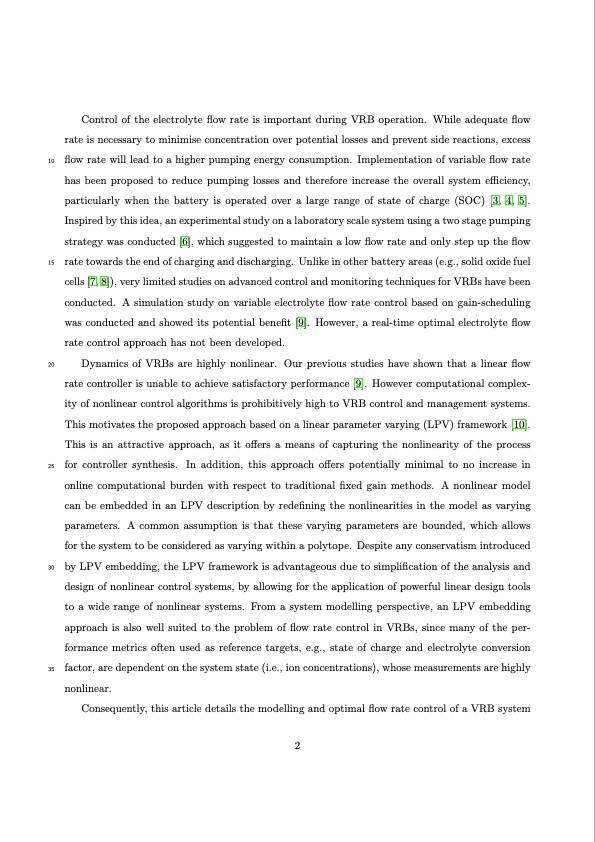
PDF Publication Title:
Text from PDF Page: 002
Control of the electrolyte flow rate is important during VRB operation. While adequate flow rate is necessary to minimise concentration over potential losses and prevent side reactions, excess 10 flow rate will lead to a higher pumping energy consumption. Implementation of variable flow rate has been proposed to reduce pumping losses and therefore increase the overall system efficiency, particularly when the battery is operated over a large range of state of charge (SOC) [3, 4, 5]. Inspired by this idea, an experimental study on a laboratory scale system using a two stage pumping strategy was conducted [6], which suggested to maintain a low flow rate and only step up the flow 15 rate towards the end of charging and discharging. Unlike in other battery areas (e.g., solid oxide fuel cells [7, 8]), very limited studies on advanced control and monitoring techniques for VRBs have been conducted. A simulation study on variable electrolyte flow rate control based on gain-scheduling was conducted and showed its potential benefit [9]. However, a real-time optimal electrolyte flow rate control approach has not been developed. 20 Dynamics of VRBs are highly nonlinear. Our previous studies have shown that a linear flow rate controller is unable to achieve satisfactory performance [9]. However computational complex- ity of nonlinear control algorithms is prohibitively high to VRB control and management systems. This motivates the proposed approach based on a linear parameter varying (LPV) framework [10]. This is an attractive approach, as it offers a means of capturing the nonlinearity of the process 25 for controller synthesis. In addition, this approach offers potentially minimal to no increase in online computational burden with respect to traditional fixed gain methods. A nonlinear model can be embedded in an LPV description by redefining the nonlinearities in the model as varying parameters. A common assumption is that these varying parameters are bounded, which allows for the system to be considered as varying within a polytope. Despite any conservatism introduced 30 by LPV embedding, the LPV framework is advantageous due to simplification of the analysis and design of nonlinear control systems, by allowing for the application of powerful linear design tools to a wide range of nonlinear systems. From a system modelling perspective, an LPV embedding approach is also well suited to the problem of flow rate control in VRBs, since many of the per- formance metrics often used as reference targets, e.g., state of charge and electrolyte conversion 35 factor, are dependent on the system state (i.e., ion concentrations), whose measurements are highly nonlinear. Consequently, this article details the modelling and optimal flow rate control of a VRB system 2PDF Image | Electrolyte Flow Rate Control Vanadium Redox Flow Batteries

PDF Search Title:
Electrolyte Flow Rate Control Vanadium Redox Flow BatteriesOriginal File Name Searched:
2201-12812.pdfDIY PDF Search: Google It | Yahoo | Bing
Salgenx Redox Flow Battery Technology: Salt water flow battery technology with low cost and great energy density that can be used for power storage and thermal storage. Let us de-risk your production using our license. Our aqueous flow battery is less cost than Tesla Megapack and available faster. Redox flow battery. No membrane needed like with Vanadium, or Bromine. Salgenx flow battery
| CONTACT TEL: 608-238-6001 Email: greg@salgenx.com | RSS | AMP |